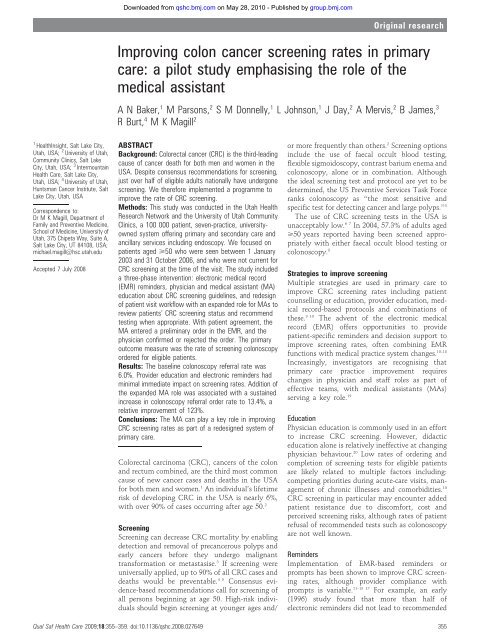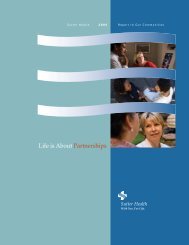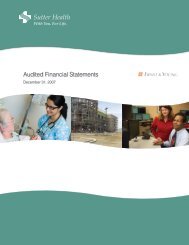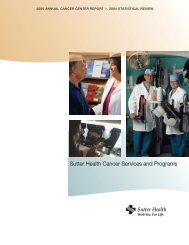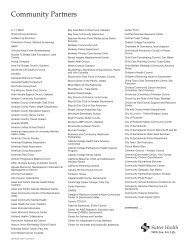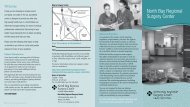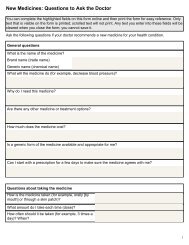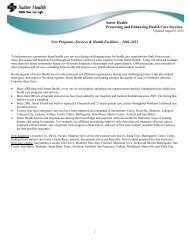Improving Colon Cancer Screening Rates In Primary ... - Sutter Health
Improving Colon Cancer Screening Rates In Primary ... - Sutter Health
Improving Colon Cancer Screening Rates In Primary ... - Sutter Health
Create successful ePaper yourself
Turn your PDF publications into a flip-book with our unique Google optimized e-Paper software.
Downloaded from qshc.bmj.com on May 28, 2010 - Published by group.bmj.com<br />
Original research<br />
<strong>Improving</strong> colon cancer screening rates in primary<br />
care: a pilot study emphasising the role of the<br />
medical assistant<br />
A N Baker, 1 M Parsons, 2 S M Donnelly, 1 L Johnson, 1 J Day, 2 A Mervis, 2 B James, 3<br />
R Burt, 4 M K Magill 2<br />
1 <strong>Health</strong><strong>In</strong>sight, Salt Lake City,<br />
Utah, USA; 2 University of Utah,<br />
Community Clinics, Salt Lake<br />
City, Utah, USA; 3 <strong>In</strong>termountain<br />
<strong>Health</strong> Care, Salt Lake City,<br />
Utah, USA; 4 University of Utah,<br />
Huntsman <strong>Cancer</strong> <strong>In</strong>stitute, Salt<br />
Lake City, Utah, USA<br />
Correspondence to:<br />
Dr M K Magill, Department of<br />
Family and Preventive Medicine,<br />
School of Medicine, University of<br />
Utah, 375 Chipeta Way, Suite A,<br />
Salt Lake City, UT 84108, USA;<br />
michael.magill@hsc.utah.edu<br />
Accepted 7 July 2008<br />
ABSTRACT<br />
Background: Colorectal cancer (CRC) is the third-leading<br />
cause of cancer death for both men and women in the<br />
USA. Despite consensus recommendations for screening,<br />
just over half of eligible adults nationally have undergone<br />
screening. We therefore implemented a programme to<br />
improve the rate of CRC screening.<br />
Methods: This study was conducted in the Utah <strong>Health</strong><br />
Research Network and the University of Utah Community<br />
Clinics, a 100 000 patient, seven-practice, universityowned<br />
system offering primary and secondary care and<br />
ancillary services including endoscopy. We focused on<br />
patients aged >50 who were seen between 1 January<br />
2003 and 31 October 2006, and who were not current for<br />
CRC screening at the time of the visit. The study included<br />
a three-phase intervention: electronic medical record<br />
(EMR) reminders, physician and medical assistant (MA)<br />
education about CRC screening guidelines, and redesign<br />
of patient visit workflow with an expanded role for MAs to<br />
review patients’ CRC screening status and recommend<br />
testing when appropriate. With patient agreement, the<br />
MA entered a preliminary order in the EMR, and the<br />
physician confirmed or rejected the order. The primary<br />
outcome measure was the rate of screening colonoscopy<br />
ordered for eligible patients.<br />
Results: The baseline colonoscopy referral rate was<br />
6.0%. Provider education and electronic reminders had<br />
minimal immediate impact on screening rates. Addition of<br />
the expanded MA role was associated with a sustained<br />
increase in colonoscopy referral order rate to 13.4%, a<br />
relative improvement of 123%.<br />
Conclusions: The MA can play a key role in improving<br />
CRC screening rates as part of a redesigned system of<br />
primary care.<br />
Colorectal carcinoma (CRC), cancers of the colon<br />
and rectum combined, are the third most common<br />
cause of new cancer cases and deaths in the USA<br />
for both men and women. 1 An individual’s lifetime<br />
risk of developing CRC in the USA is nearly 6%,<br />
with over 90% of cases occurring after age 50. 2<br />
<strong>Screening</strong><br />
<strong>Screening</strong> can decrease CRC mortality by enabling<br />
detection and removal of precancerous polyps and<br />
early cancers before they undergo malignant<br />
transformation or metastasise. 3 If screening were<br />
universally applied, up to 90% of all CRC cases and<br />
deaths would be preventable. 4 5 Consensus evidence-based<br />
recommendations call for screening of<br />
all persons beginning at age 50. High-risk individuals<br />
should begin screening at younger ages and/<br />
or more frequently than others. 2 <strong>Screening</strong> options<br />
include the use of faecal occult blood testing,<br />
flexible sigmoidoscopy, contrast barium enema and<br />
colonoscopy, alone or in combination. Although<br />
the ideal screening test and protocol are yet to be<br />
determined, the US Preventive Services Task Force<br />
ranks colonoscopy as ‘‘the most sensitive and<br />
specific test for detecting cancer and large polyps.’’ 3<br />
The use of CRC screening tests in the USA is<br />
unacceptably low. 6 7 <strong>In</strong> 2004, 57.3% of adults aged<br />
>50 years reported having been screened appropriately<br />
with either faecal occult blood testing or<br />
colonoscopy. 8<br />
Strategies to improve screening<br />
Multiple strategies are used in primary care to<br />
improve CRC screening rates including patient<br />
counselling or education, provider education, medical<br />
record-based protocols and combinations of<br />
these. 9 10 The advent of the electronic medical<br />
record (EMR) offers opportunities to provide<br />
patient-specific reminders and decision support to<br />
improve screening rates, often combining EMR<br />
functions with medical practice system changes. 10–18<br />
<strong>In</strong>creasingly, investigators are recognising that<br />
primary care practice improvement requires<br />
changes in physician and staff roles as part of<br />
effective teams, with medical assistants (MAs)<br />
serving a key role. 19<br />
Education<br />
Physician education is commonly used in an effort<br />
to increase CRC screening. However, didactic<br />
education alone is relatively ineffective at changing<br />
physician behaviour. 20 Low rates of ordering and<br />
completion of screening tests for eligible patients<br />
are likely related to multiple factors including:<br />
competing priorities during acute-care visits, management<br />
of chronic illnesses and comorbidities. 10<br />
CRC screening in particular may encounter added<br />
patient resistance due to discomfort, cost and<br />
perceived screening risks, although rates of patient<br />
refusal of recommended tests such as colonoscopy<br />
are not well known.<br />
Reminders<br />
Implementation of EMR-based reminders or<br />
prompts has been shown to improve CRC screening<br />
rates, although provider compliance with<br />
11–15 17<br />
prompts is variable. For example, an early<br />
(1996) study found that more than half of<br />
electronic reminders did not lead to recommended<br />
Qual Saf <strong>Health</strong> Care 2009;18:355–359. doi:10.1136/qshc.2008.027649 355


